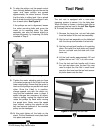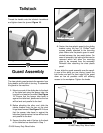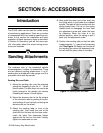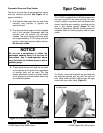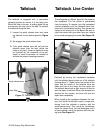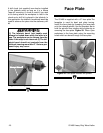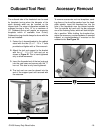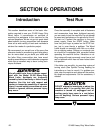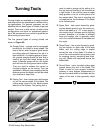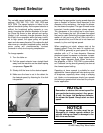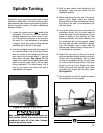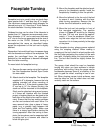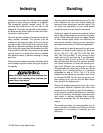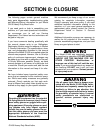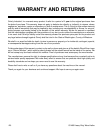
G1495 Heavy-Duty Wood Lathe
-25-
Indexing can be used for cutting evenly spaced
grooves or flutes along the length of a spindle.
The headstock spindle indexes every 30˚ by
inserting the knockout bar into the hole in the
headstock. This locks the spindle in that position,
the lathe should not be turned on when the index-
ing feature is being used.
Once the spindle is locked, the groove can be cut
using several methods. The grooves can be
marked out by using the edge of the tool rest as
a straight edge. Extra length tool rests are avail-
able as an optional accessory should the length
of the fluting be longer than the standard tool rest.
The groove can then be cut by hand using a wood
carving chisel. Or a hand plane can be outfitted
with special cutters to achieve reeding or fluting
style cuts.
There are also accessory devices available which
can be used to guide a router along the length of
the spindle.
Indexing
Turnings can be sanded while they are still in the
lathe, however the tool rest should always be
removed when performing sanding steps. This
will avoid any possibility of your hand getting
caught between the rest and the workpiece.
Sanding is useful to remove any surface defects
which may still be present from the turning oper-
ations. Quite frequently there are ridges, bumps
or other uneven spots which can effectively be
removed by sanding. Sanding is also necessary
to prepare the project for final finish application.
When sanding it is best to proceed through a pro-
gression of abrasive grits (typical grit sizes are
60, 80, 100, 120, 150, 180, 220, 240, 280, 320,
360, 400, 500 and 600). If your turning is fairly
rough start at 60 and work up. If it is smoother,
you may be able to start at the 80-120 range.
Most woodturners discover that as their skill with
the chisels improves, so does the resulting sur-
face finish. Whether you need to go as high as
600 depends upon what type of finish you will be
applying. For a painted surface it is generally
acceptable to stop at 120 or 150. If it is to be
stained and varnished you generally need to go
to at least 280-320. And if it will not get any sur-
face coating at all, you will find the best results
from going to the highest grits.
During the sanding process be sure not to over
sand certain features. Spindles will often have
sharp corners or beading as part of the design. It
is very easy to remove these features in just a few
seconds of sanding. Sandpaper strips are often
very useful in sanding spindles while turning,
these can be worked into the fine details of the
project.
The sanding process can also generate a lot of
heat so be sure to protect your hands, or be less
aggressive in the amount of material you are
removing.
Sanding
Never start the lathe with the knockout bar
inserted in the indexing hole. Serious per-
sonal injury may occur.



